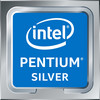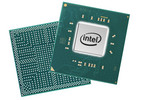Intel Pentium Silver J5040 vs Intel Pentium Silver N5030 vs Intel Celeron N4120
Intel Pentium Silver J5040
► remove from comparison
The Intel Pentium Silver J5040 is a quad-core SoC primarily for inexpensive mini-PCs and was announced late 2019. It runs at 2 GHz (base) to 3.2 GHz (single core burst) and is based on the Gemini Lake platform (refresh). Similar to the Apollo Lake predecessor, the chip is manufactured in a 14 nm process with FinFETs but offers slightly improved processor cores, double the amount of L2 cache, a smaller package, a better GPU architecture and a partly integrated WiFi support. Besides four CPU cores, the chip also includes a DirectX 12 capable GPU as well as a DDR4/LPDDR4 memory controller (dual-channel, up to 2400 MHz). The SoC is not replaceable as it is directly soldered to the mainboard.
Architecture
The processor architecture is still called Goldmont Plus. Compared to the older Goldmont cores in Apollo Lake, they feature an increased level 2 cache (to 4 MB). That means the per-clock-performance should be a bit better, but not near the Core CPUs like Kaby Lake Y.
Performance
Thanks to the higher clock speed and TDP, the Pentium J5040 is slightly faster than the mobile counterpart, the Pentium Silver N5030. Compare to AMD, it ranks on average slightly higher compared to the Athlon Silver 3050e (Zen based Dual-Core) that wins in single-core tests but looses out in multi-threaded tests. Intel Core i3 from 2019 (like the i3-1005G1) are clearly faster and win even in multi-threaded tests easily although being only dual-core CPUs.
GPU Performance
The UHD Graphics 605 (Gemini Lake) is based on Intel's Gen9 architecture, which supports DirectX 12 and is also used for the Kaby Lake / Skylake / Apollo Lake graphics adapters (like HD Graphics 520). Equipped with 18 EUs and a clock of up to 800 MHz, the performance should be roughly on par with the older HD Graphics 5300 and HD Graphics 505 (Apollo Lake).
The chip also includes an advanced video engine with hardware support for the playback of VP9 and H.265 material (8-bit color-depth).
Power Consumption
The J-variant of the Gemini Lake SoCs are specified at 10W TDP and therefore higher than the mobile N variants (6 Watt).
Intel Pentium Silver N5030
► remove from comparison
The Intel Pentium Silver N5030 is a quad-core SoC primarily for inexpensive notebooks and was announced late 2019. It runs at 1.1-3.1 GHz (Single Core Burst) and is based on the Gemini Lake platform. The 5030 is the refresh of the older Pentium 5000 and offers a 400 MHz higher Boost clock. Similar to the Apollo Lake predecessor, the chip is manufactured in a 14 nm process with FinFETs but offers slightly improved processor cores, double the amount of L2 cache, a smaller package, a better GPU architecture and a partly integrated WiFi support. Besides four CPU cores, the chip also includes a DirectX 12 capable GPU as well as a DDR4/LPDDR4 memory controller (dual-channel, up to 2400 MHz). The SoC is not replaceable as it is directly soldered to the mainboard.
Architecture
The processor architecture is still called Goldmont Plus. Compared to the older Goldmont cores in Apollo Lake, they feature an increased level 2 cache (to 4 MB). That means the per-clock-performance should be a bit better, but not near the Core CPUs like Kaby Lake Y.
Performance
The average N5030 in our database proves unable to beat the AMD 3020e, an entry-level dual-core CPU of similar power efficiency, in multi-thread performance, rendering the Pentium a poor option for anything but the most basic day-to-day activities, as of late 2022.
GPU Performance
The UHD Graphics 605 (Gemini Lake) is based on Intel's Gen9 architecture, which supports DirectX 12 and is also used for the Kaby Lake / Skylake / Apollo Lake graphics adapters (like HD Graphics 520). Equipped with 18 EUs and a clock of up to 750 MHz, the performance should be roughly on par with the older HD Graphics 5300 and HD Graphics 505 (Apollo Lake).
The chip also includes an advanced video engine with hardware support for the playback of VP9 and H.265 material (8-bit color-depth).
Power consumption
Like most N-class Intel chips, the Pentium has a default TDP, also known as the long-term power limit, of 6 W. This is low and thus good enough for passively cooled tablets, laptops, mini-PCs and handhelds.
The Intel Pentium N5030 is built with one of the old 14 nm Intel processes making for poor, as of early 2023, energy efficiency.
Intel Celeron N4120
► remove from comparison
The Intel Celeron N4120 is a quad-core SoC primarily for inexpensive notebooks and was announced late 2019. It runs at 1.1-2.6 GHz (Single Core Burst) and is based on the Gemini Lake platform. Compared to the predecessor, the Celeron N4100, the refresh offers a 200 MHz higher Boost clock. Similar to the Apollo Lake predecessors, the chip is manufactured in a 14 nm process with FinFETs but offers slightly improved processor cores, double the amount of L2 cache, a smaller package, a new generation of monitor outputs (Gen 10) and a partly integrated WiFi chip. Besides four CPU cores, the chip also includes a DirectX 12 capable GPU as well as a DDR4/LPDDR4 memory controller (dual-channel, up to 2400 MHz). The SoC is not replaceable as it is directly soldered to the mainboard.
Architecture
The processor architecture ist still called Goldmont Plus. Compared to the older Goldmont cores in Apollo Lake, they feature an increased level 2 cache (to 4 MB). That means the per-clock-performance should be a bit better, but not near the Core CPUs like Kaby Lake Y.
Performance
The average N4120 in our database is not much faster than AMD's Zen-based, affordable Athlon Silver 3050e, as far as multi-thread benchmark scores are concerned, with the Intel Celeron 6305 and the Core i5-7Y54 found close nearby as well. It's a very basic CPU that we're talking about here. While it does have four cores, these are some seriously slow cores, dashing hopes of anybody looking to get a Core i3-like performance for cheap.
GPU Performance
The UHD Graphics 600 (Gemini Lake) is based on Intel's Gen9 architecture, which supports DirectX 12 and is also used for the Kaby Lake / Skylake / Apollo Lake graphics adapters (like HD Graphics 520). Equipped with 12 EUs and a clock of up to 700 MHz, the performance should be roughly on par with the older HD Graphics 500 (Apollo Lake).
The chip also includes an advanced video engine with hardware support for the playback of VP9 and H.265 material (8-bit color-depth).
Power Consumption
Just like most other N-class Intel processors, Celeron N4120 has a default TDP of 6 W (also known as PL1), making it a good option for passively cooled laptops, tablets, mini-PCs. It's manufactured on a very old (as of late 2022) 14 nm process, though, making for poor energy efficiency.
| Model | Intel Pentium Silver J5040 | Intel Pentium Silver N5030 | Intel Celeron N4120 | ||||||||||||||||||||||||||||||||||||||||||||||||||||||||||||||||||||||||
| Codename | Gemini Lake Refresh | Gemini Lake Refresh | Gemini Lake Refresh | ||||||||||||||||||||||||||||||||||||||||||||||||||||||||||||||||||||||||
| Series | Intel Gemini Lake | Intel Gemini Lake | Intel Gemini Lake | ||||||||||||||||||||||||||||||||||||||||||||||||||||||||||||||||||||||||
| Series: Gemini Lake Gemini Lake Refresh |
|
|
| ||||||||||||||||||||||||||||||||||||||||||||||||||||||||||||||||||||||||
| Clock | 2000 - 3200 MHz | 1100 - 3100 MHz | 1100 - 2600 MHz | ||||||||||||||||||||||||||||||||||||||||||||||||||||||||||||||||||||||||
| L2 Cache | 4 MB | 4 MB | 4 MB | ||||||||||||||||||||||||||||||||||||||||||||||||||||||||||||||||||||||||
| Cores / Threads | 4 / 4 | 4 / 4 | 4 / 4 | ||||||||||||||||||||||||||||||||||||||||||||||||||||||||||||||||||||||||
| TDP | 10 Watt | 6 Watt | 6 Watt | ||||||||||||||||||||||||||||||||||||||||||||||||||||||||||||||||||||||||
| Technology | 14 nm | 14 nm | 14 nm | ||||||||||||||||||||||||||||||||||||||||||||||||||||||||||||||||||||||||
| max. Temp. | 105 °C | 105 °C | 105 °C | ||||||||||||||||||||||||||||||||||||||||||||||||||||||||||||||||||||||||
| Socket | FCBGA1090 | BGA1090 | BGA1090 | ||||||||||||||||||||||||||||||||||||||||||||||||||||||||||||||||||||||||
| Features | Intel UHD Graphics 605 (18 EUs, 200 - 750 MHz), Quick Sync, AES-NI, max. 8 GB Dual-Channel DDR4/LPDDR4-2400 | DDR4-2400/LPDDR4-2400 RAM, PCIe 2, MMX, SSE, SSE2, SSE3, SSSE3, SSE4.1, SSE4.2, VMX, SMEP, SMAP, MPX, EIST, TM1, TM2, Turbo, AES-NI, RDRAND, RDSEED, SHA, SGX | DDR4-2400/LPDDR4-2400 RAM, PCIe 2, MMX, SSE, SSE2, SSE3, SSSE3, SSE4.1, SSE4.2, VMX, SMEP, SMAP, MPX, EIST, TM1, TM2, Turbo, AES-NI, RDRAND, RDSEED, SHA, SGX | ||||||||||||||||||||||||||||||||||||||||||||||||||||||||||||||||||||||||
| iGPU | Intel UHD Graphics 605 (250 - 800 MHz) | Intel UHD Graphics 605 (200 - 750 MHz) | Intel UHD Graphics 600 (200 - 700 MHz) | ||||||||||||||||||||||||||||||||||||||||||||||||||||||||||||||||||||||||
| Architecture | x86 | x86 | x86 | ||||||||||||||||||||||||||||||||||||||||||||||||||||||||||||||||||||||||
| Announced | |||||||||||||||||||||||||||||||||||||||||||||||||||||||||||||||||||||||||||
| Manufacturer | www.intel.com | ark.intel.com | ark.intel.com |
Benchmarks
Average Benchmarks Intel Pentium Silver J5040 → 100% n=30
Average Benchmarks Intel Pentium Silver N5030 → 84% n=30
Average Benchmarks Intel Celeron N4120 → 81% n=30
* Smaller numbers mean a higher performance
1 This benchmark is not used for the average calculation













